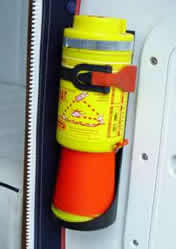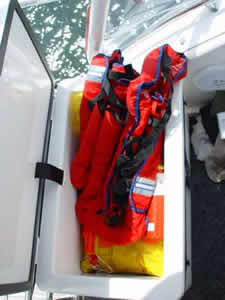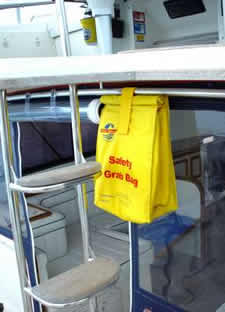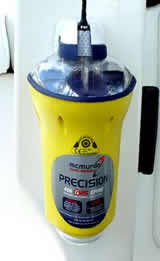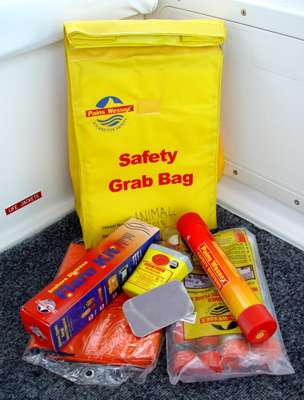6. Safety
Between The Lines - Ch10: Boat Setu
Before you leave the dockIt doesn't matter if you are the skipper of a small or large boat, you are responsible for the safety of everyone onboard. Before you leave the dock to carry out the following safety checklist of essential items to ensure you have a safe day on the water.
In each state and territory, there are a set of regulations that cover recreational boating and you need to consult the regulations in your area to check the specific requirements. There is usually a safe boating or recreational boating handbook published as a ready-reference guide to safety legislation. In general, all states are consistent on the need for boating safety but differ in the definition of specifics. That is, what is defined as partially smooth waters in one state may be described as inland waters in another state. In one state you must wear a personal floatation device (Vid 1) - lifejacket or PFD (Vid 2) - when the boat is underway, whereas in other states they just need to be onboard. Also, the requirements for licenses for the skipper can vary between states and territories so make sure yours is the right one and is current. (These requirements are minimal; every effort should be made to investigate your exact needs based on the value you place on your life and those in your care.)
Commercial vessels are covered by a complete set of regulations specifically covering the requirements for each vessel, based on the class of boat. In this discussion here we will be only covering recreational vessels and we need to think about the following before we head out. Is the boat safe, are the conditions safe?- Has it been serviced regularly, is it due for service now? If it is then get it done before you take a group of friends out on the water. - You should check the hull and deck of the boat regularly for any damage, if you find any then fix it. - Fuel, do you have enough? A useful rule of thumb is the one-third rule, whereby you have one-third of fuel to get to your destination, one-third to get home and one-third in reserve. A change of conditions from when you left may mean that you head out in calm conditions but have to come home into a strong wind and rising swell. - Check the weather reports for the day and the times you are planning to be out. Are there any warnings current? Check local marine radio or a weather website and local authorities. - Is the marine battery in good condition, do you have a spare one onboard as a back-up? A faulty battery has too often been found responsible for many of the electrical and engine problems encountered onboard. Think about it - no battery then no radio and you can't receive the warnings or use the radio for assistance. Where are you going today?- There are different safety equipment requirements depending on how far offshore you plan to go. For example, generally, if you are going more than 2 nautical miles offshore then you must carry an emergency position indicating radio beacon known as an EPIRB. (Fig 1)
- Tell someone else where you plan to go today and when you will return. For example, leave a note on the fridge for the family, local authority or with a neighbour. But, in fairness to the neighbour and the family, let them know when you have returned so they don't start to worry unnecessarily. - If you change your plans let them know. Are there any specific hazards where you are going? - Is there a bar crossing in the trip, are there shipping channels or isolated dangers? Make sure you and your guests are ready for these events. - Plan your trip; you should know how long it is going to take and what route to use. Size of the boat, is it safe?- How many people are you planning to take with you today? Make sure the boat is capable of carrying them. In some states, the regulations specify the capacity, based on length of the boat. For example, a vessel greater than 5m and less than 5.5m can carry 6 people. - Overloaded boats are dangerous. Who do you have with you today?- You should know a little about the people you have onboard, as they may be a friend of a friend, so ask a question or two and show them the safety gear. - Can they swim? If anyone is a non-swimmer, make sure they are wearing a PFD at all times. - Tell them your safety rules for the boat. - Where are the PFD's? Show them how to put one on. - Show them where the other safety gear is, such as flares, EPIRBs, oars etc, and then let them read the instructions so they can operate the equipment if required. Do you have a crew member onboard today?- Can they take over if you, the skipper becomes incapacitated, by a heart attack, for example? You need someone onboard who can get you home if a problem crops up. - Can they operate the radio? Make sure someone else knows how to use it. Do you have the right safety gear onboard? (Fig 2)- You need to check your local recreational or safe boating handbook, published by the applicable department of your state government, for the specific requirements and definitions in your area, but the following is considered the minimum sort of equipment you should carry. - Make sure that all the equipment is accessible and everyone knows where it is kept. (Fig 3) - Store items like flares in a container to keep them dry and in good condition. - Make sure your guests know how the equipment is used. Let them read the instructions. - If carrying an EPIRB, have you carried out a self-test in the last month? If not do so.
Other considerations- Be conscious of the weather conditions: - If hot, do you have sunscreen on hand? - If cold, do you have extra jumpers, jackets or waterproof clothing? - If anyone onboard requires medication ensure they have it with them and they know how to administer it. - For longer trips make sure you have ample drinking water and food onboard. - If you are loading the boat up with additional equipment make sure that you distribute it and your guests around the boat to maximise stability. - Check the bilge for any fuel leaks, if any present rectify before proceeding. - Alcohol - generally the same rules apply as if on the road. Over 0.05 blood alcohol will incur penalties in Australian waters. Reflexes and response times to emergencies are slowed and swimming ability deteriorates considerably. The safety handbook in your state will confirm the above information, for your specific location, and also gives you valuable information on navigation, general rules of operating on the waterways, lights, buoys and channel markers. In an EmergencyEven for the most prepared skipper, an emergency can arise at any time and you need to know what to do, instinctively. So you need to understand the equipment you have onboard, how it is used when it is used and then tell others onboard. You can consider practising the use of some of the equipment, for example, have you ever tried to put a PFD on when you are already in the water? If not, try it out one day while you are still at the dock, it is not as easy as you think. Which distress signal do I let off at night? Of course, you let off the red flare, but which is that in the packet when it is pitch dark and you can't see the colour of the label. Did you know they sometimes have a tactile on the top which is designed to let you feel which one is in your hand? Where is the EPIRB, how do you turn it on, what do you attach it to and should you leave it on? The answer to the latter is yes, leave it on until a member of a search and rescue organisation tells you to turn it off. There are lots of things for the skipper to think about and know, so let's go through a few of the critical things to do in some common emergency situations. Fire- Even though you are surrounded by water, it is often difficult to get enough of it to the heart of the blaze. So what do you do? - Raise the alarm. - Maneuver the vessel to keep the wind from fanning the flames. - If the burning object can be removed, get it over the side as quickly as possible. - If a fuel fire, turn off gas or petrol supply if possible. - If you have an extinguisher point at the base of the fire, not the flames, then activate. The extinguisher should be a powder type, suitable for the fires you are likely to encounter onboard. Read the instructions on the side of the extinguisher. Keep yourself to windward. - Most fires on small craft come from fuel, heating appliances, stoves, leaking gas or cooking fat. - Don't dump fuel cans over the side, the fire could spread in the water. - Never allow the fire to get between you and the exit in cabin craft. Sinking or abandoning the boat- Try to locate the leak and reduce the flow by pushing something into the hole. - Bail as best you can. - Raise the alarm. - All onboard should put a lifejacket on. - Stay with the boat, even if it submerges or turns over. In all likelihood, part of the boat will remain above or near the surface and it is much easier for rescue personnel to spot the hull of a boat than a head bobbing in the water. - Once in the water reduce your energy use by adopting a huddle position to reduce body heat loss. - Try to stay calm. Restrain the impulse to swim ashore. Distances over water usually appear to be much less than they really are, so unless you know land is inside your swimming distance it is better to stay with the boat. - If there is more than one of you then huddle together to give support and retain heat. When people fall overboard- Don't jump in after them, you might double the potential drowning. - Put the engine in neutral. - Raise the alarm. - Swing the propeller quickly away from them. - Throw them a lifebuoy ring, horseshoe or lifejacket. - Keep them in sight at all times, if possible have someone act as a lookout so the skipper can maneuver the boat. - Normally, try to approach them from downwind or into the sea. Help them back into the boat, over the stern in small boats or over the lowest point of the freeboard. Engine Failure- Even a well-maintained engine may fail so it is important you have some basic knowledge of what to do. - Practice emergency repairs on your engine and always carry at least a minimum of essential tools. - Before carrying out running repairs use an anchor to check drift, also keep the bow pointed into the sea. As this helps keep water out of the engine. - Wet ignition can often frustrate attempts to restart. - It is worthwhile to learn the sound of your engine when it is running well, this will help you identify problems early and prevent a total breakdown. - If you cannot make repairs and you have a total breakdown then you need to raise the alarm. Stay with the boat. Raising the AlarmThis has been mentioned in each of the emergency situations and we need to look at the best procedure to do this. Marine Radio- A distress call should be made if in a grave and imminent danger. - It should be on the distress frequency - channel 16 on VHF and channel 88 on the 27MHz frequency. - The distress call is :- Mayday Mayday Mayday- This is- Name & radio call sign of the vessel in distress spoken 3 times- Mayday- Name and radio call sign of the vessel- Details of vessel's position- Nature of distress and assistance required- Other information including the number of people onboard.- Repeat as often as required until you receive a response.Mobile Phone- You can ring 000 from your phone but remember these are not as good as the radio as they have limited battery life and generally will not work if wet. EPIRB's
- Where carried require a couple of steps to activate them. This is to reduce the number of accidental activations. EPIRBs operate by sending a signal to an overhead satellite system which relays the message through to the rescue centre in nominated localities (in Australia, this is Canberra). The centre then contacts the local search and rescue authorities to coordinate the search. The EPIRB, depending on the type you have onboard, gives the search authorities your position. The more recent 406MHz products will give your identity and a more accurate position as well. (Fig 4) To activate: - Remove from the bracket, or pouch if a personal one is carried. - Attach the tether to something that is floating. Ideally, the boat if it is not sinking, otherwise attach to your body. - Raise the aerial. - Turn the switch on. You will see a flashing light and sometimes a sound will activate to indicate the EPIRB is on. - Leave the unit on until the rescue authorities advise to turn it off. An EPIRB will run for more than 48 hours. Marine Distress Signals- These are more commonly called flares and most boaters will have an inshore kit, coastal kit or offshore kit onboard. (Fig 5) These generally have two red flares (Vid 3) for use during the night and two orange smoke signals for daytime use.
- They should be used when you think potential rescuers are in sight. - There have been many types sold over the years so you should look at your stock and read the instructions on use. Generally, the operating instructions will be. - Check the correct daytime or nighttime signal has been selected. - Read the name of the signal. - Check colour code. - Raised ‘O' for Orange for daytime use, ‘+' for Red for night time use. - Twist off the top cap. - Holding the yellow handle and with the signal pointing up and away from you, firmly pull the yellow igniter knob, on the top of the signal, up and out of the signal in a smooth steady motion. This is for the latest model flares. - Hold the ignited signal up, outboard and to leeward of your vessel. - Note there may be a slight delay between pulling out the ignition knob and the ignition of the signal.
- Dispose of used signals (which will be hot) by throwing overboard. - The older modes operate as follows: - Twist off the top cap. - Remove the bottom striker cap from the handle and strike firmly across the top ignition surface with the coated part of the striker cap. - Both hand-held Orange Smoke Signals produce a vivid cloud of orange smoke and are used to raise alarm and pinpoint position and should only be used when potential rescuers are in sight. They are visible for 60 seconds and can be seen for up to 4km away in daylight. - Both red hand-held flares raise the alarm to help pinpoint position. They are for night use in particular but can be used during the day. They burn for 60 seconds and can be seen approximately 10km away on a clear night at sea level and up to 20km at night from an aircraft. - A parachute red distress rocket is used for long-range distress alerts. To operate follow the instructions clearly printed on the side of the signal. V-Sheet - This orange sheet with a black ‘V' on it can be used to raise the alarm. - Raising and lowering arms in a continuous slow motion is recognised as a distress signal. - You can use a heliograph, signalling mirror or torch to communicate an alarm condition. The safety handbook in your state will confirm the above information, for your specific location, and also gives you valuable information on navigation, general rules of operating on the waterways, lights, buoys and channel markers. Enjoy your day and stay safe.
|





